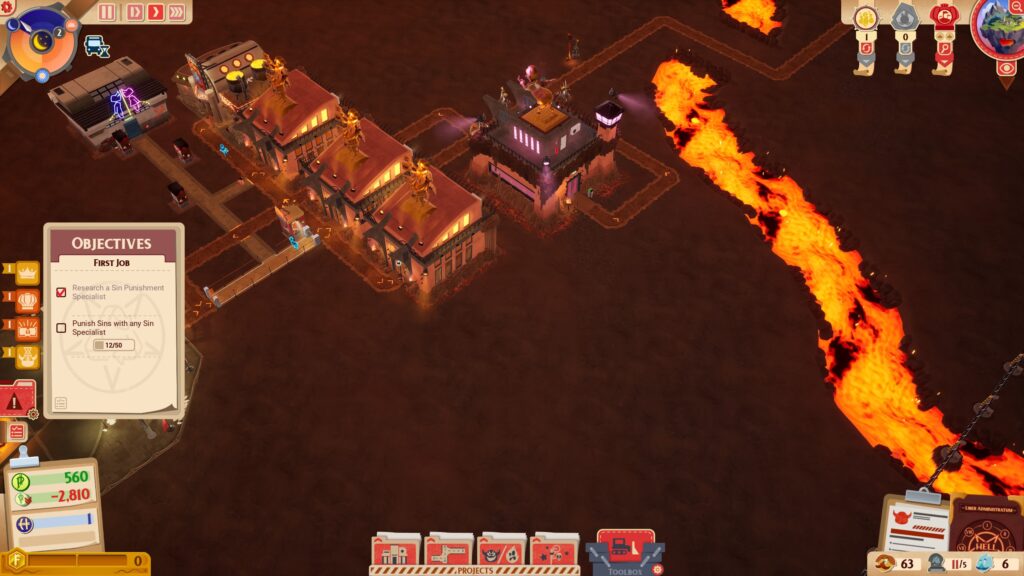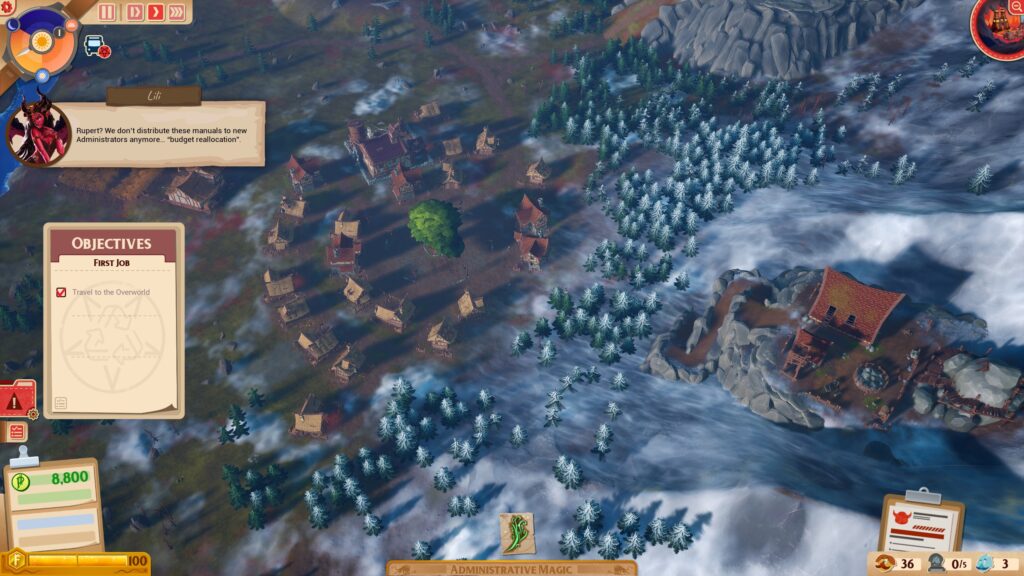When playing Sintopia, the phrase “This is my hell” came to mind. Everybody has probably said that at some point, but I’m guessing one of those times was while behind a desk or a counter, staring at the clock, hoping the last five minutes of work will tick away. This is why the idea of hell being a bureaucratic nightmare seems like such an enticing motif. Television, like Lucy, Daughter of the Devil, Purgatony, and most recently Hazbin Hotel, have all, in some context, depicted the monotony of paper pushing juxtaposed with the brutality of eternal damnation. Have A Nice Death also explored this theme in game form, though with much more action.
Sintopia feels like an oddity in that regard, as it actually explores a functioning bureaucracy. As a management sim, you, the player, assume the role of the new manager of hell. Or, at least this universe’s version of it. Here, Humus, the version of humans that exist, live on a flat surface above the inner sanctum that you have control over. They die above, get bused below; you are tasked with guiding them along a walkway to the structure that revives them so they can begin the cycle anew. It’s a straightforward premise, but even for a genre that is often defined by an overabundance of tutorials can get pretty complicated.

In the demo, you play through two tutorials as well as a challenge stage, which gives you more freedom with some twists in your limitations. There is a story mode planned for later release, but the game is lacking that currently. The shame of this is, the player is given the freedom once learning the basics to jump into a mode where you’re kinda expected to know more. There is a lot of freedom in this mode, which does give the demo some girth you might not expect, and a decent amount of replayability, but you need to commit to some self learning to achieve this.
On the lower level, you build one-way pathways designed to guide souls to the exit, and despite the game giving you some idea that you can walk them into a corner and lose them, you really can’t, as they simply get stuck. Along these paths, you place buildings that are designed to extract the mortal sins of the dead, lowering them in the souls and benefiting you with currency to keep your hell scape growing. This includes branching the paths so that multiple functioning buildings can deal with the rehabilitation of the wayward souls. This seems simple enough, but as this expands, you dive into the seven deadly sins that each soul can be corrupted with, and as you expand, specific buildings to address those and earn increased reward for you.

Managing the Humus traversing the fires of hell isn’t the only thing you do, as all these buildings need people, or should I say Imps, to run them. You can hire from three categories for the structures you create, and you need to pay them, as well as create paths for them, as well as private rooms, like a restroom that they can use. Not all of these things felt useful, though. The game teaches you how to create a ticket booth, for instance, to control the flow of the dead. Once I used this in free use, it felt like it caused massive pile-ups rather than reduced issues. You are given a way to speed up Imps on break or doing something, but in certain cases, this becomes a frustration because Imps, like the ticket booth, seem to need prodding every two seconds, a frustrating endeavor.
Every day, you need to pay your employees as well, weighing how much you are making against what is needed to pay the staff. Where this gets interesting is that going in the red isn’t a loss; Hell doesn’t get shut down, no, your Imps will go on strike. This will affect only a certain number of employees for part of the day, based on how under you were, so you might not meet the requirement, but only see one building go on strike. A more annoying function is the currency required to keep everything running, which plays into both building and paying staff. There were points where I lacked the funds to advance my Hell, but I was also not functionally making money to do so, putting me in a position of waiting and hoping this would change. It does feel at times that you lack control despite the massive amount of control they give for creating your path.

On the flip side of this coin, you can go to the surface and interact with the living Humus as well, though with less control here. You have magic, such as a strong gust to ‘help’ some people along to your domain, or water to help them. They have rules, warriors, and works, and your choices do have weight here, even if you don’t really control this portion of the board. If you don’t like how the ruler is guiding society, kill him and let a replacement guide it in a different direction. You can allow the living to play into certain sins, or prevent them with your magic. All of these have a benefit to your growing empire, and, as it seems, when we have more options later on when the game releases, learning which way you want to bend society through your influence should play a massive part.
Sintopia is an interesting blend of a life, or should I say death, sim, with a management and bureaucracy at its center. The straight path your souls walk to redemption is deceptively simple, with multiple mechanics in the background to build on top and create a complex loop that should become rewarding as you start to piece it all together. The two different worlds you get to interact with also offer unique types of gameplay that feel interestingly at odds with each other, which makes the experience all the better for it. I look forward to finally getting to run hell to my heart’s desire next year, but for now, Sintopia makes for a demo you should play.
Remember to follow us on Twitter, Facebook, and Bluesky to keep up to date on everything we have going on!
*A code was provided by Team17 for the purposes of this preview.